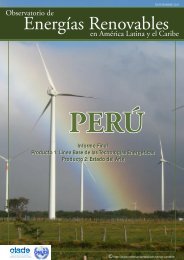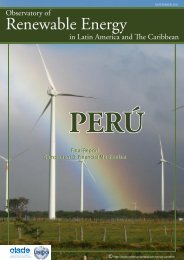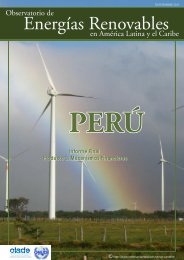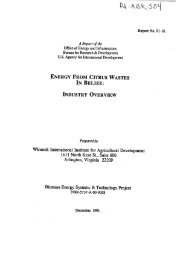PERÃ - Observatory for Renewable Energy in Latin America and
PERÃ - Observatory for Renewable Energy in Latin America and
PERÃ - Observatory for Renewable Energy in Latin America and
Create successful ePaper yourself
Turn your PDF publications into a flip-book with our unique Google optimized e-Paper software.
<br />
Perú- Products I <strong>and</strong> II<br />
<br />
1.4 Legal <strong>and</strong> Institutional Framework of <strong>Renewable</strong> Energies<br />
In this section it is presented the legal framework of electricity activities, barriers<br />
that had to be faced up <strong>for</strong> the hydroelectric development, measures to promote<br />
the <strong>in</strong>vestment <strong>in</strong> a new generation supply, general tariff regime, characteristics of<br />
the electricity market, legal framework of renewable energies, tax <strong>in</strong>centives <strong>and</strong><br />
the results of the application of the legal framework.<br />
1.4.1 General Legal Framework of Electricity Activity<br />
The General Regulatory Framework <strong>for</strong> the tariff / remunerative regimen is<br />
established by L.D. Nº 25844 “Electrical Concessions Law” - ECL (enacted on<br />
November of 1992), the Law Nº 28832 “Law to ensure the Efficient Development<br />
of the Electricity Generation” (enacted on July of 2006) <strong>and</strong> its bylaws.<br />
1.4.1.1 Barriers <strong>for</strong> the Development of Hydroelectric Power Stations<br />
In Peru, an important part of the <strong>in</strong>stalled capacity through Hydroelectric Power<br />
Stations <strong>in</strong> the SEIN was built by the State, most of which have been privatized<br />
from the decade of 90. S<strong>in</strong>ce then, only three Hydroelectric Power Stations were<br />
built by <strong>in</strong>itiative of private <strong>in</strong>vestors. These are the Hydroelectric Power Stations<br />
“Yanango” of 42.6MW <strong>and</strong> “Chimay” of 150,9 MW which entered <strong>in</strong>to<br />
commercial transaction <strong>in</strong> 2000, as well as the Hydroelectric Power Station “El<br />
Planatanal” of 220 MW, which entered <strong>in</strong>to commercial transaction <strong>in</strong> December<br />
of 2010 33 . The ma<strong>in</strong> barriers <strong>for</strong> the development of hydroelectric projects<br />
compared with other technologies like thermal plants of natural gas are:<br />
a) Amounts of Investment<br />
Hydroelectric Power Stations are characterized by hav<strong>in</strong>g low production costs<br />
(stage of operation), but very high <strong>in</strong>vestment costs compared with other types of<br />
technologies. For <strong>in</strong>stance, <strong>for</strong> each MW of <strong>in</strong>stalled capacity, it is required an<br />
<strong>in</strong>vestment between 1.2 <strong>and</strong> 1.8 million US$, <strong>and</strong> <strong>for</strong> a natural gas thermal power<br />
station with simple cycle, it is required an <strong>in</strong>vestment of 0.5 million US$'s.<br />
b) Periods of Construction<br />
The large-sized Hydroelectric Power Stations have construction periods of an<br />
average of 4 to 5 years, while natural gas thermal power stations are built <strong>in</strong> a<br />
year or a year <strong>and</strong> a half, approximately.<br />
Larger periods imply higher f<strong>in</strong>ancial expenses dur<strong>in</strong>g the construction stage of a<br />
Hydroelectric Power Station, which would have <strong>in</strong>come over the sixth year while<br />
a thermal power station would have them be<strong>for</strong>e the second year.<br />
<br />
3 In the case of the “El Platanal” H.P.S, its construction started on March of 2006, however the<br />
f<strong>in</strong>al concession <strong>for</strong> this project was given on July of 2001. The <strong>in</strong>iciative of the prívate <strong>in</strong>vestor<br />
was manifested <strong>in</strong> 1996, giv<strong>in</strong>g temporal concession on November of 1996, which shows that<br />
s<strong>in</strong>ce the first prívate <strong>in</strong>iciative til the execution of works it passed over 10 years, <strong>and</strong> add<strong>in</strong>g the<br />
4 years of construction, make a total of 14 years <strong>for</strong> the commercial transaction of the project.<br />
One of the ma<strong>in</strong> difficulties that this project had was the f<strong>in</strong>anc<strong>in</strong>g.<br />
<br />
40









